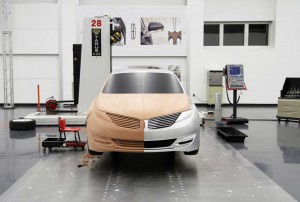Ford Motor Co. has opened a dedicated Lincoln Design Center in Dearborn, Michigan, part of its effort to put the long-struggling brand back on track as a true competitor to marques like BMW, Lexus – and even the resurgent cross-town competitor Cadillac.
The new design center and studio will house approximately 150 designers, craftspeople and engineers dedicated solely to Lincoln production and concept vehicles, Ford said. It also marks the first time in 40 years that all the disciplines required to develop a new vehicle for Ford’s up-market brand, both creative and technical, will work collaboratively in one space.
Setting up the new design center is all part of Ford’s efforts to reinvent the Lincoln brand, executives said. Once a serious competitor to Cadillac as dominant players in the U.S. market, Lincoln has become a weak second-tier nameplate – and one with virtually no presence outside North America.
Ford hopes to change that situation by rolling out more stylized, technically sophisticated products – including an all-new version of the Lincoln MKZ coming for 2013. It has an assortment of additional models under development but industry observers warn that Lincoln now has to prove it has a unique identity and isn’t just a marketing operation for slightly more up-market versions of vehicles sold by the mainstream Ford “Blue Oval” brand.
The dedicated Lincoln Product Development organization will help create four all-new Lincoln vehicles by 2015 to ensure the reinvented brand has a presence in the highest growth segments of the premium market, according Raj Nair, Ford group vice president, Global Product Development,
“We have spent considerable time to develop strong integrated design, engineering and product programs into a common Product Development vision for Lincoln,” Nair said. “Lincoln’s advantage is we can build on the company’s tremendous global product development resources and ensure we continually innovate to develop the best technology and apply it to support the unique Lincoln difference,” he said.
The test of that will begin with the U.S. roll-out of the new MKZ but an even bigger test of Lincoln’s global potential will follow as the marque prepares to make its debut in China a few years from now. That booming Asian nation is now the fastest-growing market for luxury vehicles.
Until recently, Ford said it had no ambitions for Lincoln beyond the U.S. and a few secondary markets. But the challenge is making a business case competing against players like BMW, Mercedes-Benz or Lexus who can count on the economies of scale generated by worldwide marketing, analysts argued.
That appears to have resonated with Ford management, especially CEO Alan Mulally, who has tried to merge the maker’s global operations into a unified system. Nonetheless, pulling off a turnaround in the American market will be critical.
“During the great recession, the U.S. luxury market had changed. Now, there is opportunity for a fresh, new alternative in the premium market,” said Jim Farley, group vice president, Global Marketing, Sales and Service. “Lincoln’s renaissance is built on our new product lineup and is a personalized experience with designs that deliver on our promise of a personalized motor car: beautiful, elegant, and most of all, surprising.”
Max Wolff, Lincoln’s Director of Design, is responsible not only for the design of all Lincoln vehicles but also the environment in which they will be created.
The new operation is intended to be a place where designers and engineers truly collaborate. The loft-like studio replaces walls with glass. Cubicles are banished in favor of open workspaces where designers sit across from one another. The entire space is configured to allow product development team members to drop in, have ad-hoc discussions and make impromptu innovative brainstorm sessions the order of the day and not the exception.
“We also made it a priority to fit interior and exterior design teams into one space because often they are two separate work streams and therefore, two different sensibilities,” Wolff said. “Now everyone collaborates on one harmonious vehicle.”
Paul A. Eisenstein contributed to this report.


